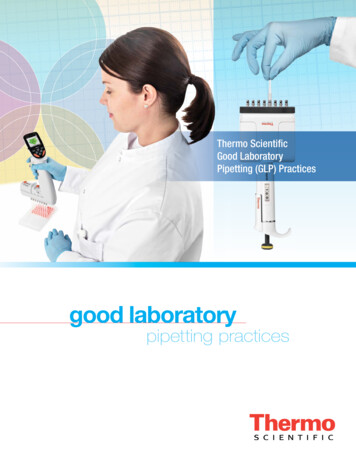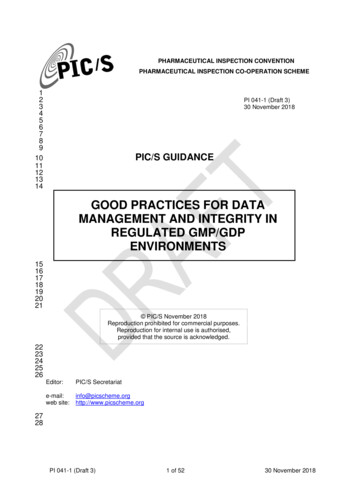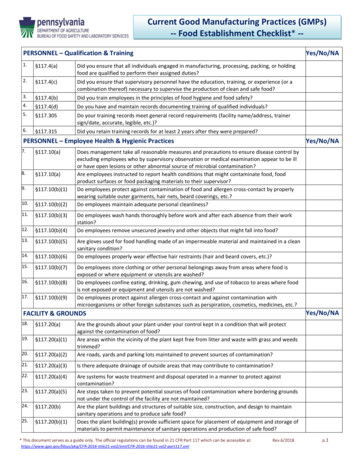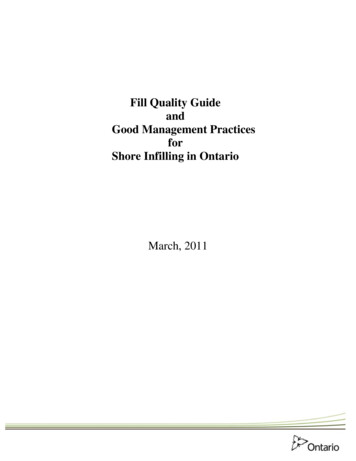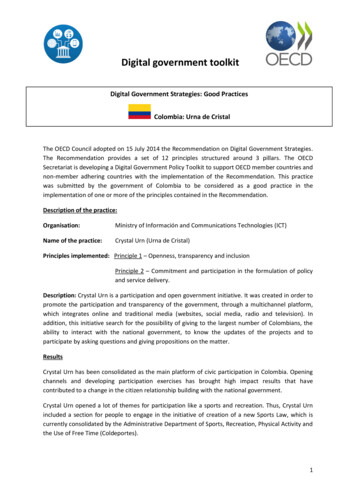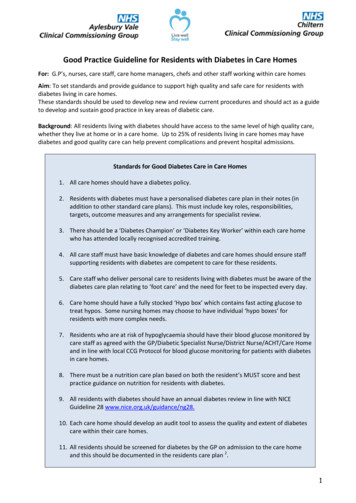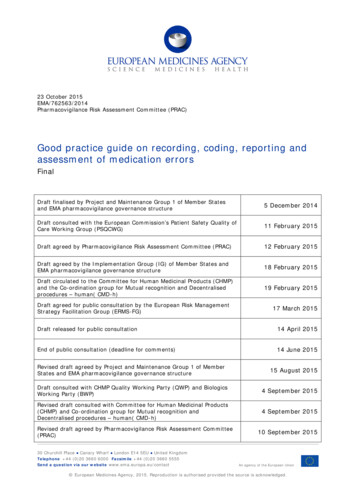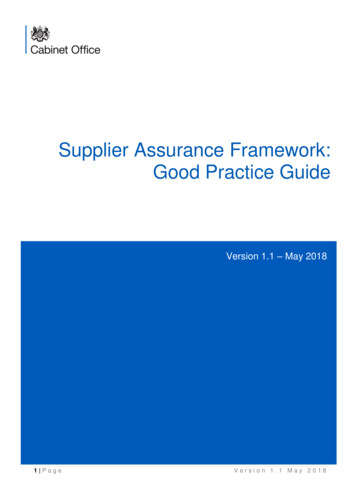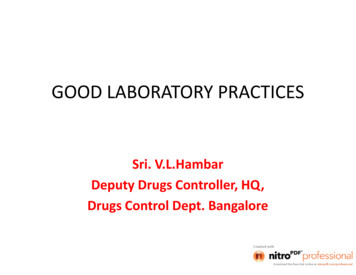
Transcription
GOOD LABORATORY PRACTICESSri. V.L.HambarDeputy Drugs Controller, HQ,Drugs Control Dept. Bangalore
INTRODUCTION NUMBER OF COUNTRIES REQUIRE THEMANUFACTURERSTOPERFORMLABORATORY STUDIES ON SUCH PRODUCTSFOR THEIR PROPERTIES AND SAFETY ANDTO SUBMIT THE RESULTS OF THESE STUDIESTO GOVERNMENT AUTHORITY/REGULATORYAUTHORITIES FOR THE ASSESSMENT OFPOTENTIAL HAZARDS TO HUMAN HEALTHAND THE ENVIRONMENT AND HAVE PASSEDLEGISLATION TO THAT EFFECT .
AMENDMENT Good Laboratory Practices has been made aslaw by introducing it as Schedule L-1 which is aNew Schedule under Drugs and CosmeticsRules, 1945 vide Gazette notification no GSR780 (E) 10-11-2008 with effect from 1-11-2010.Consequent to this amendment, Rule 74, 78 andRule 150E of the Drugs and Cosmetics Rules,1945 have been amended. It involves a numberof good practices in the Quality Controllaboratory which are to be undertaken to carryout an analysis with a defined degree ofAccuracy & Precision.
Definition of GLP Good Laboratory Practices(GLP) is a qualitysystem concerned with the organizationalprocess and the conditions under which nonclinical health and environmental safetystudies are planned, performed, monitored,recorded, archived and reported.
The purpose of GLP The principle of Good laboratory practice(GLP) : to promote the development of qualityand validity of test data used for determiningthe safety of chemicals, Pharmaceuticals,Food, Cosmetics etc.
Importance of G L PSincerawmaterials,packagingmaterials, intermediates and finishedproducts are ultimately releasedbased on the analytical resultsgenerated in the Q.C. Laboratory,Accuracy, Precision and Reliability ofthese results are of paramountimportance.
GMP vs. GLPLaboratoryProcessesSamplesResults ofAnalysisGood Laboratory PracticesRaw MaterialsPackaging MaterialsManufacturingProcessesGood Manufacturing PracticesFinished Product ofStandard Quality
Schedule-L1 l requirementsPremisesPersonalEquipmentsChemicals & ReagentsGood House Keeping and SafetyMaintenance , calibration, and validation of equipmentsReference materialsMicrobiological culturesQuality systemInternal quality system auditsManagement reviewStandard Operating ProceduresProtocols and Specifications archiveRaw dataStorage and archival
Factors influencing implementation &maintenance of GLP in Q.C. laboratoryLaboratory infrastructure.Reference Standards & reference microbial cultures.Quality of analytical Reagents & Chemicals.Quality of Volumetric glass wares.Preparation of Standard solutions and reagent solutions.Calibration of Equipments / instruments & volumetric glasswares.Validation of Analytical methods specially non-pharmacopoeialmethods.Proper documentation of analytical methods, specifications &protocol of tests.Training of analysts: formal & informalGood Safety practices.
Laboratory Infrastructure General Chemical LaboratoryThe specific requirements are: Well ventilated, lighted and preferably air conditioned tomaintain a temperature of 27 10C. Fitted with proper laboratory furnitures and fixtures . Instrument Room:The specific requirements are: Temperature: 25 10C Relative humidity : 45 5%. Constant supply of Electricity No vibrational disturbances. Separate room for housing semi-micro & microbalances.
Laboratory Infrastructure Microbial Laboratory: Air conditioned, preferably with AHU with suitablefilter (5 micron or less). Fitted with proper laboratory furnitures & fixtures anda change room. For units having both sterile & non – sterile productsthere should be two aseptic zones having class 1000area with LAF and entry through graded air zones,one for inoculation and cultures transfer and anotherfor sterility testing. For units having only non-sterileproducts, one aseptic zone shall be there.
Laboratory Infrastructure Hot Zone :For housing Hot Air Oven, Muffle Furnace, FumeCupboard, Autoclaves etc. one Hot Zone is required. Thiszone should have proper ventilation system. Package Material Testing Section :The specific requirements are: Adequate space, Required equipments and instrument. Furnitures & Fixtures.
Laboratory Infrastructure Retained Sample Area :This is required for storage & preservation ofretained samples of both finished products and activeraw materialsThe specific requirements are: Proper temperature control (wherever required) Proper demarcation for finished products and active rawmaterials. Cleaning Area:The specific requirements are: Suitable size Provided with facilities like running hot and cold water,purified water, different cleaning agents for glassapparatus.
Laboratory Infrastructure Storage Area for Lab Chemicals, Glass Apparatus &Miscellaneous Items:There should be an adequate area with proper demarcation andproper temperature control wherever required for storage oflaboratory chemicals, solvent, glass apparatus & miscellaneousitems.In addition to these, there should be adequate arrangementsfor all types of services like vacuum, compressed air, nitrogen,potable water, purified water, ultra-pure water etc. indifferent sections of Q.C. Lab.
Reference Standard Primary reference Standards for active & inactive bulk drugs ofIP, BPCRS, EPCRS, USP grade Reference standards for impurities wherever applicable andavailable Procurement from respective authorities likeCentral Drugs Laboratory, Kolkata; United StatesIP Commission, Pharmacopoeia Convention (USPC)etc. Proper Preservation (i.e. at controlled temperatureand humidity etc.)
Reference Standard Development of suitable working Standard fromavailable active raw materials with the help ofthese primary standards. Identification and Storage of working standardswith expiry date, retest date and otherappropriate information. Documentation of all information regarding theseprimary standards and working standards.
Reference Microbial Cultures Reference microbial cultures Procurement from Central Drugs Laboratory, Kolkata;National Collection of Type Culture (N.C.T.C.) U.K. andAmerican Type Culture Collection (A.T.C.C.) U.S.A.wherever required. Proper Maintenance in the microbial lab as perrespective pharmacopoeia. Proper documentation.
Analytical Reagents & ChemicalsAll analytical Reagents and Chemicals should be ofanalyticalreagentsgradesofsuitablemanufacturer. These should comply with thespecification for reagents given in differentpharmacopoeia. The specification of the reagentsrequired must be mentioned clearly in the testmethod.
Volumetric GlasswareTwo grades of volumetric glassware are used in thelaboratoryClass A: with test certificate, as per specificationlaid down by B.I.S.Class B as B.I.S.Class A are to be used for Work of the highestaccuracy like standardization of volumetric solutions &Class B for routine work. Cleanliness of glasswareshould be ensured before use and periodic validation inthis respect are to be done.
Preparation of Standard solutionsand reagentAll standard solutions (reference standardsand volumetric Standards) and reagentssolution must have proper labels indicatingname, strength, date of preparation, date ofexpiry and storage conditions. Properdocumentation having details of preparationof these solution are to be maintainedchronologically.
Validation of Analytical ProcedureAll non Pharmacopoeial analytical methods havingtests for identity, impurity / impurities & purity are tobe validated properly before use in respect of –1. Accuracy2. Precision3. Specificity4. Linearity and Range5.6.7.8.Limit of DetectionLimit of QuantitationRobustness andRuggedness(as applicable for each individual method).For detailed methods of validation ICH guidelinesmay be referred.
Calibration of Equipments andinstrumentsCalibration is the comparison of the performance of ameasuring equipment / instrument with that of standardequipment / instrument.In a Quality Control lab, all equipments and instrumentswhich are directly or indirectly used for measurement areto be calibrated periodically.
Types of Calibration1.Calibration by external agency:Some measuring equipments / instruments like pressuregauge, thermo dials, glass thermometers, wet and dry bulbhygrometers, balances etc. can be calibrated with the help ofan NABL accredited external agency.2.Calibration in the laboratory r, Polarimeter etc can be calibratedinternally using methods described in pharmacopoeia.
Types of Calibration3.4.Calibration in the laboratory with the help of external agencyCertain instruments like HPLC, gas chromatograph, particlecounters etc. are to be calibrated with the help ofprocedures described in the operating manual and/ or servicemanual of these instruments.Calibration by Validation of the respective procedure:Some equipments/ instrument may be calibrated indirectly byvalidation of the respective procedure. For example: Monitoring of the autoclaving process in an autoclave with thehelp of Bacillus stearothermophyllus spore strip .
TrainingAll laboratory personnel (managers, supervisory staffs,analysts, technicians, helpers and others) should haveregular training and updation.Training can be of two types –1. Formal training : This may cover different topicslike analytical chemistry, statistical techniques,microbial techniques, instrumental techniques,electronic data processing, documentation etc.1. Informal training : Informal or on the job traininginvolves laboratory skills .Records of training must be kept.
Documentation & RecordsUsual Document and records with which Q C Laboratory has to deal with are – Specification Test Procedure Standard Operating Procedures Certificate of Analysis with relevant Test Protocols Sample Register Register for Reference Standards & Reference Cultures Calibration Records Validation Records Training Records Records for Retained samples (Both finished products & active raw materials) Records pertaining to the preparation of solutions of reference standards,volumetric solutions and other reagents. Log book for instruments & equipments.All documents are to be reviewed periodically and updated whenever required.Records should be maintained in such a manner that these are always traceable. Ifrequired help of electronic data processing system may be taken.
SafetyIn the Quality Control Laboratory, one has to handle a no ofhazardous, poisonous and inflammable chemicals and alsopathogenic organisms. Hence the adoption of proper safetymeasure and use of safety devices are of paramountimportance.The use of mask, gloves, face shields, aprons, gumboots etc.should be made compulsory in the handling of corrosivechemicals. There should be adequate fire fightingarrangements in the laboratory and personnel should be givenproper training for fire fighting.Training for other safety measures should be impartedregularly and records of these training should be maintained.Microbial residues should be regularly destroyed by autoclavingand records maintained.
A General Checklist for GLP Implementation (1)Good house-keeping,(2) Quality Manual/Documentation,(3) Quality Policy,(4) Method Validation,(5) Instrumental Validation,(6) System Suitability Tests,(7) Calibration ofEquipments/Instruments/ CalibrationSchedules/Traceability,
Checklist for GLP (8) Equipment Log Books, (9) Standard Analytical Reference Samplesand their Traceability(All relatedCertificates/Documentation), (10) Archives for Samples and Documents,(11) Specifications for the productsinvestigated, (12) Good Vendor Development, (13) Study Director for Projects, (14) Statistical Evaluations,
Checklist (15) Staff proficiency, Health and Safety, (16) Procedures for Receiving, Dealing andDisposing Samples, (17) Environmental monitoring in workingareas, (18) Effluent Treatment Monitoring andControl,
Checklist (19) Participation in Proficiency TestingPrograms, (20) Internal Audits/Checklists, (21) Management Review Meetings, (22) Official Audits/Surveillance Audits, (23) Customer Complaints—Procedures to dealwith them and Finding Solutions, (24) Validation of Computer Systems andSoftwares, (25) Continuous Performance Assessment of QAGroup, (26) Raw Data Collection/Traceability of Data
Checklist (27) Continuous upgradation of knowledge ofall Personnel through Systematic TrainingPrograms, (28) Material Safety Data Sheets –ToxicityInformations, Antidotes for allDangerous/Hazardous Chemicals, (29) First Aid Facilities, (30) Assignment of Clear and UnambiguousResponsibilities to VariousOfficers/Personnel,
Checklist (31) Standard Operating Procedures, (32) Sampling Procedures,A set of highly qualified, experienced,dedicated and motivated persons to carryout the GLP program. Even if all the otherconditions are satisfied, the GLP programwill meet with failure, if adequate andcompetent Human Resources are notavailable.
Gains Better results. Management assured throughinternal QA unit that the studies it managesare done to a certain standard. Very fewstudies are now repeated because ofprocedural problems. Studies are generallybetter protocolled/conducted/reported.
Gains All the data produced are now held in securearchives, facilitating its recovery for bothinternal use and when required byRegulatory bodies. Regular inspection/auditshave ensured that companies maintain theirstandards at a high level.
Gains Studies done under GLP aredefinitely more acceptable toRegulatory bodies. Non GLP data are liable to getrejected.
Losses/Disadvantages Costs: Initially about 20% high. Later on 5%. Industry has lost some of its freedom. A more stereotyped approach to scientificwork. Many scientists may leave testing asthey dislike to work under such constraints.
Losses/Disadvantages Proliferation of documentation,though better organised andstored than ever before. The gains far outweigh thelosses.
CONCLUSIONIn concl
Calibration of Equipments / instruments & volumetric glass wares. Validation of Analytical methods specially non-pharmacopoeial methods. Proper documentation of analytical methods, specifications & protocol of tests. Training of analysts: formal & informal Good Safety practices. Laboratory Infrastructure ðüGeneral Chemical Laboratory The specific requirements are: ðvWell ventilated, lighted .
